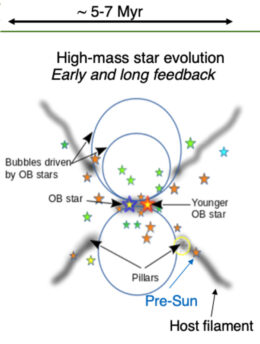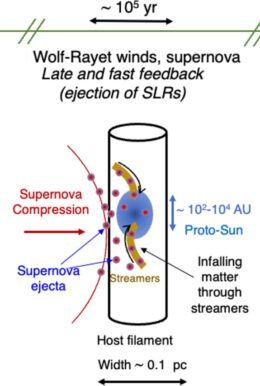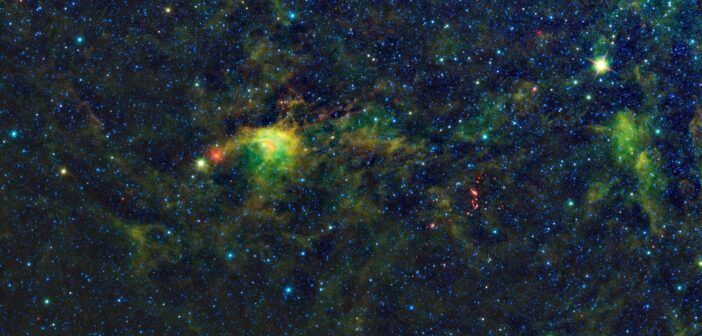The radioactive atoms found in meteorites tell a subtle and complicated story about the Sun’s birth. In a recent article, researchers translated this story to discover that our solar system could have formed in a dense molecular cloud buffeted by a supernova.
Meteorites as Messengers from the Early Solar System

In the hub–filament model of star formation, low-mass stars form in dense molecular cloud filaments, while high-mass stars form where filaments meet. [Adapted from Arzoumanian et al. 2023]
In a recent research article, Doris Arzoumanian (National Astronomical Observatory of Japan) and collaborators discussed the radioactive content of meteorites in the context of what’s known as the hub–filament model. In this model, Sun-like stars form along narrow, dense clouds of molecular hydrogen gas known as filaments, while massive stars form where two or more filaments meet — at a hub. Arzoumanian and coauthors suggested that the hub–filament model might provide a natural way to explain the amounts of radioactive species found in meteorites.

Nearby high-mass stars of spectral type O and B suffuse their surroundings with high-energy photons, heating the gas. A dense filament might shield a young star from this radiation. [Adapted from Arzoumanian et al. 2023]
Forming on a Filament
Radioactive atoms can be incorporated into a budding solar system in a few ways. They can be present in the cloud material from which the planetary system forms, placed there by previous generations of massive stars; they can be produced when atoms within the cloud are bombarded by high-energy charged particles from outside the galaxy; or they can be injected by a nearby massive star through winds or a supernova explosion. Based on the particular blend of radioactive atoms found in meteorites, Arzoumanian’s team favors the last explanation, though that opens a new question: how did our nascent solar system survive a supernova next door?
This is where the hub–filament model shows its usefulness. While a planetary system in the early stages of formation should be disrupted by a supernova, a dense filament could shield the young Sun and its planet-forming material. Not only does the filament protect the planetary system, it may also provide a natural way to funnel radioactive-species-rich material to the system via accretion streamers, which have been observed in young star systems.
A Supernova Solution

Massive stars add short-lived radionuclides (SLRs) like aluminum-26 to their surroundings. [Adapted from Arzoumanian et al. 2023]
These calculations show that a 25-solar-mass star exploding as a supernova or an even more massive (40–60 solar masses) star shaking off material through stellar winds could provide the abundance of aluminum and its daughter elements that we find in meteorites. Future simulations should explore these scenarios in more detail.
Citation
“Insights on the Sun Birth Environment in the Context of Star Cluster Formation in Hub–Filament Systems,” Doris Arzoumanian et al 2023 ApJL 947 L29. doi:10.3847/2041-8213/acc849

